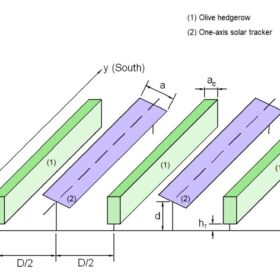JA Solar files patent infringement lawsuit against Astronergy
JA Solar has filed two patent lawsuits against Astronergy in the Unified Patent Court (UPC). The proceedings are related to the tunneling silicon oxide (SiO2) layers, the doped polysilicon layer, and the electrodes used in tunnel oxide passivated contact (TOPCon) solar products.
Solar cell based on ferroelectric 2D/3D/2D perovskite junction achieves 24% efficiency
The experimental device achieved an open-circuit voltage of 1.21 V, which is the highest value reported to date for highly efficient perovskite photovoltaics. The cell is based on a photo-ferroelectric 2D/3D/2D perovskite junction integrating a 2D ferroelectric perovskite single crystals in the perovskite bulk.
Runergy urges US authorities to revoke two of Trina Solar’s TOPCon patents
Runergy is pushing the US Patent and Trademark Office (USPTO) to cancel Trina Solar’s tunnel oxide passivated contact (TOPCon) patents, US9,722,104 and US10,230,009.
Agrivoltaics for hedgerow olive orchards
Researchers in Spain have created a new model to accurately estimate oil production and energy generation in agrivoltaic facilities built in hedgerow olive orchards. The proposed approach also allows the generation of mathematical equations estimating the influence of the system design variable.
Lebanese sources confirm just one damaged PV array after reports of blasts
Lebanon’s National News Agency (NNA) has reported that “several” solar arrays have been linked to a second wave of electronic-device explosions across the nation, but local sources have thus far only identified one damaged PV system, which they said was likely affected by external factors.
Cando Solar unveils frameless 450 W heterojunction PV panels with 22.6% efficiency
The Chinese manufacturer says its new frameless heterojunction panels rely on busbarless technology and 210 mm wafers. The new products also feature a temperature coefficient -0.29%/C and weigh only 12.3 kg.
MIT scientists build PV-driven desalination system that reacts to changes in sunlight
The proposed brackish water desalination system uses photovoltaic electrodialysis to enable direct-drive desalination at high production rates. It already operated for 6 months on real brackish groundwater and was reportedly able to use 94% of the extracted PV energy.
Czechia planning retroactive cuts to feed-in tariffs for PV systems
The Czech government is trying to retroactively reduce feed-in tariffs (FITs) granted for PV projects between 2006 and 2013. The local solar sector has criticized the move, claiming that it could incite panic among investors.
The impact of sodium, moisture on heterojunction PV module performance
Researchers in France have investigated heterojunction solar module reliability in damp heat environment and have found that sodium ions are the main source of degradation.
UK startup unveils industrial heat pump for hot water, steam generation
Futraheat has developed a 300 kW/1.5 MW heat pump that can reportedly deliver steam up to 130 C and reach a coefficient of performance of 6.2. The first prototype was deployed at a brewery in Sussex.










